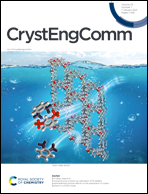Novel silver(i) cluster-based coordination polymers as efficient luminescent thermometers†
Abstract
By employing a triazole–pyridine-containing ligand, two novel coordination polymers with Ag(I) clusters exhibiting different architectures have been successfully constructed. Structural analysis indicates that diverse coordination modes of the N-donor linker are responsible for the network difference for these two compounds, affording an isolated cluster for 1 and a 2D framework for 2, respectively. Compound 1 features a butterfly-shaped [Ag8(bptp)4(H2O)2] cluster wherein strong argentophilic interactions could be observed. The linkage of Ag(I) with N and I centers gives rise to a tetranuclear building unit [Ag4(bptp)3I] in 2, which is further extended to a 2D network with the assistance of the N-donor linkers. The syntheses and crystal structures have been investigated. Solid-state photoluminescence emissions as well as luminescence lifetimes of 1 and 2 have also been studied. Moreover, temperature-dependent luminescence tests show that an excellent linear relationship between temperature and emission intensity in the ranges of 77–298 K and 77–200 K could be observed for compounds 1 and 2, respectively. The wide temperature sensing range especially for 1 implies that they could act as promising ratiometric fluorescence molecular thermometers.

- This article is part of the themed collection: Crystal Growth


 Please wait while we load your content...
Please wait while we load your content...